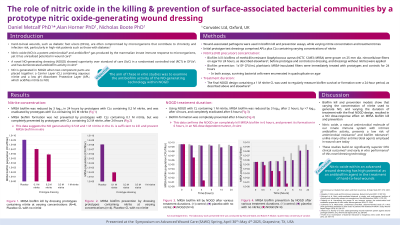Laboratory Research
(LR-029) The Role of Nitric Oxide in the Killing and Prevention of Surface-associated Bacterial Communities by a Prototype Nitric Oxide-generating Wound Dressing
Friday, May 2, 2025
7:45 PM - 8:45 PM East Coast USA Time

Nicholas Boote, PhD – Director, Advanced Wound Care R&D, Convatec; Alan Horner, PhD – Head of Translational Sciences, Medical and Clinical Affairs, Convatec
Introduction: Hard-to-heal wounds, such as diabetic foot ulcers, pose a significant clinical challenge, resulting in poor patient quality of life and substantial economic burden. The aim of these in vitro studies was to demonstrate the activity of nitric oxide (NO), based on acidified sodium nitrite (NaNO2), within a novel prototype NO-generating wound dressing technology*, against surface-associated bacterial communities.
Methods: Initial prototype test dressings comprised upper absorbent layers plus lower carrier layers (CL) containing varying concentrations of NaNO2. To examine killing effects, surface-associated communities of methicillin-resistant Staphylococcus aureus (MRSA) were grown on nitrocellulose filters for 24 hours, before prototype/control dressings were applied. To assess the prevention of development of surface-associated communities, planktonic MRSA-inoculated filters were immediately covered with prototype/control dressings for 24 hours. The effect of treatment time with a final dressing design* containing a 1M NaNO2 CL was assessed regularly over a 24-hour period to evaluate killing and prevention of surface-associated bacterial communities.
Results: Surface-associated MRSA was reduced by 3 log10 in 24 hours by prototypes with CL containing 0.2M NaNO2, and was eradicated by dressings with CL containing 0.5M NaNO2.
Development of surface-associated MRSA communities was not prevented by dressings with CL containing 0.1M NaNO2, but was completely prevented by dressings with CL containing 0.2M NaNO2, after 24 hours. Using final design NO-generating wound dressings* with CL containing 1M NaNO2, surface-associated MRSA was reduced by 3 log10 after 2 hours, by >7 log10 after 4 hours, and completely eradicated after 6 hours. Development of surface-associated MRSA communities was completely prevented after 6 hours by the NO-generating wound dressing*.
Discussion: In vitro models of kill and prevention of surface-associated MRSA communities showed that varying the concentration of NaNO2 used to generate NO, and varying the duration of treatment with the final dressing*, resulted in a dose-response effect on the kill and prevention of surface-associated MRSA communities. The prototype NO-generating dressing* can effectively kill and prevent development of surface-associated bacteria in vitro.
Methods: Initial prototype test dressings comprised upper absorbent layers plus lower carrier layers (CL) containing varying concentrations of NaNO2. To examine killing effects, surface-associated communities of methicillin-resistant Staphylococcus aureus (MRSA) were grown on nitrocellulose filters for 24 hours, before prototype/control dressings were applied. To assess the prevention of development of surface-associated communities, planktonic MRSA-inoculated filters were immediately covered with prototype/control dressings for 24 hours. The effect of treatment time with a final dressing design* containing a 1M NaNO2 CL was assessed regularly over a 24-hour period to evaluate killing and prevention of surface-associated bacterial communities.
Results: Surface-associated MRSA was reduced by 3 log10 in 24 hours by prototypes with CL containing 0.2M NaNO2, and was eradicated by dressings with CL containing 0.5M NaNO2.
Development of surface-associated MRSA communities was not prevented by dressings with CL containing 0.1M NaNO2, but was completely prevented by dressings with CL containing 0.2M NaNO2, after 24 hours. Using final design NO-generating wound dressings* with CL containing 1M NaNO2, surface-associated MRSA was reduced by 3 log10 after 2 hours, by >7 log10 after 4 hours, and completely eradicated after 6 hours. Development of surface-associated MRSA communities was completely prevented after 6 hours by the NO-generating wound dressing*.
Discussion: In vitro models of kill and prevention of surface-associated MRSA communities showed that varying the concentration of NaNO2 used to generate NO, and varying the duration of treatment with the final dressing*, resulted in a dose-response effect on the kill and prevention of surface-associated MRSA communities. The prototype NO-generating dressing* can effectively kill and prevent development of surface-associated bacteria in vitro.

.jpg)